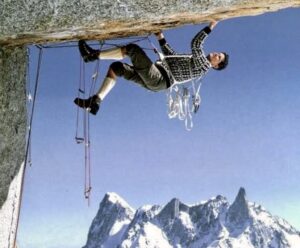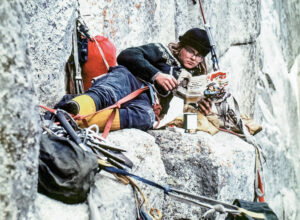In this series, we look at the world’s five highest unclimbed mountains, based on Eberhard Jurgalski’s list from 8,000ers.com. We will cover each peak’s modest climbing history and consider why no one has summited them yet.
Note that this series covers independent mountains, those that are not just secondary bumps on higher main peaks. The debate about subsidiary peaks versus independent mountains is a recurrent headache when climbers search for the “highest unclimbed peak.” Here, we are covering those unclimbed peaks for which there is no debate.
In our first three articles, we wrote about Kangkar Punzum, Lapche Kang II, and Apsarasas Kangri I. Our next peak is 7,221m Karjiang I, the fourth-highest unclimbed mountain in the world.

Kangkar Punzum and to its northeast, Karjiang. Photo: Google Earth
Karjiang
Karjiang is in Tibet, on the border with Bhutan. It is three kilometers northeast of 7,538m Kula Kangri (first ascended on April 21, 1986, by a Japanese party led by Hirai Kazumasa) and 30km northeast of Kangkar Punzum.
Just 30km north of Karjiang lies a beautiful Tibetan lake called Puma Yumco. Located 5,030m above sea level on the southern Tibetan plateau, Puma Yumco receives snow melt from the surrounding mountains. The name means “the blue jewel floating in the sky.”

Puma Yumco Lake is one of the most remote lakes in the world. Photo: ISS/NASA; Charismaticplanet
The main peak of Karjiang is the southern one, 7,221m Karjiang I, with a prominence of 895m. There are three subpeaks, the 7,216m Northwest Peak (with a prominence of 66m), 7,045m Karjiang II (with a prominence of 195m), and 6,824m Karjiang III (with a prominence of 174m).
1986 Japanese attempt
In the autumn of 1986, six climbers from the Himalayan Association of Japan, under the leadership of Nobuhiro Shingo, traveled from Lhasa to Monda. After approaching the nearby glacier on Sept. 9, the team attempted the main peak, Karjiang I.
But because of the difficulty of the terrain, they eventually changed their plan and targeted the 7,216m Northwest Peak. On Oct. 13, they set up Camp 3 at 7,000m. The following day, in a strong wind, Nobuhiro Shingo, Kenji Tomoda, and Hiroshi Iwasaki reached the Northwest summit via the northwest ridge. On Oct. 16, Tsutomu Miyazaki and Akinori Hosaka also topped out.

The Kula Kangri group. Photo: Summitpost/Culturaltreks.com
Fifteen years later
In the autumn of 2001, again during the post-monsoon season, a seven-man party from the Netherlands wanted to ascend Karjiang I. The team included Haroen Schijf, Rudolf van Aken, Pepijn Bink, Court Haegens, Willem Horstmann, and Rein-Jan Koolwijk.
On Sept. 20, they established a base camp at approximately 4,950m on the north of Karjiang. They only had photos of Karjiang’s west side, but some excellent satellite images showed Schijf that it might be possible to ascend from the northeast. So the Dutch party decided to head around to the east side of the mountain.

Karjiang and to its southwest, Kula Kangri (at right, above). Photo: Google Earth
On Sept. 24, the party established an advanced base camp. The next day, Schijf and Horstmann reached a col at about 5,800m. From there, they could contemplate the 800m northeast face of Karjiang I.
Both men agreed that this face was steeper, more difficult, and more dangerous than anything they had seen previously. They decided to abort their attempt.

Kangmi Kangri seen from Rognon of Good Hope peak. Photo: Karjiang Expeditie NKBV
Before retreating, Haegens made what was probably the first ascent of a nearby 5,881m peak, closely followed by the rest of the Dutch party. Haegens named that peak 5,881m peak Rognon of Good Hope.
On the last day of September, Schijf, Van Aken, Haegens, and Horstmann attempted to reach a 6,412m sub-summit via its west face. On the 60° ice slope, the three men only made it to 6,150m before retreating.

Karjiang and the Kula Kangri group. Photo: Budd Liu
The opposite side
Next, the Dutch team went to the opposite side of the mountain to try Karjiang I’s west face. On Oct. 4, they established an advanced base camp at 5,700m. The next day, Haegens fixed 100m of rope to protect them in a dangerous part of the icefall. That was the only length of rope used by the Dutch party during the whole expedition.
In their report for the American Alpine Journal, the team wrote that they found a lot of trash in the area. According to Schijf, the Japanese expedition had probably left it.
Two days after fixing the rope, they started up. But at 6,500m, they caused a 25m wide slab avalanche that fell 200m to the bottom of the face. No one was hurt, but the close call prompted them to reevaluate the climb. Eventually, they decided to rappel down rather than continue.

Karjiang and the Kula Kangri group. Photo: Budd Liu
Still not defeated, the party went to the Kula Kangri group to attempt one of the subpeaks. On Oct. 13, they made a summit push on the 7,381m peak from a high camp at 6,700m. But because of low temperatures and strong wind, they retreated from 7,100m.
Instead, on Oct. 19, Bink, Horstmann, Koolwijk, and Schijf made the first ascent of a 6,824m subpeak via its north face. According to Schijf, it was a beautiful pyramid. They named the peak Taptol Kangri (also sometimes called Karjiang III).

The Dutch party attempts Karjiang I. Photo: Karjiang Expeditie NKBV
Meanwhile, Van Aken and Haegens put up a camp at 6,100m on the northeast glacier of Karjiang, just below the narrow south-southwest ridge of the 6,412m subpeak. When they topped out, they named this subpeak Kangmi Kangri, which means “Yeti Snow Mountain.”
Plans foiled in 2010
In 2010, American climbers Joseph Nicholi Puryear and David Gottlieb received a Shipton-Tilman Grant for an attempt on Karjiang. However, they didn’t receive a climbing permit from local authorities. They changed their target and went to Lapche Kang, located 420km west of Karjiang. There, Puryear died in a fatal fall.

The northeast face of Karjiang. Photo: Karjiang Expeditie NKBV
Name confusion
Like Lapche Kang and Apsarasas Kangri, there is some confusion regarding the names of the various Karjiang peaks. Both the Japanese climbers who summited Karjiang’s northwest summit and the Dutch party used the wrong names for the subpeaks.
For clarity, the Japanese party in 1986 made the first ascent of 7,216m Karjiang Northwest Peak and the 2001 Dutch team made the first ascent of 6,824m Karjiang III.
Meanwhile, 7,045m Karjiang II and 7,221m Karjiang I — the only independent mountain of the Karjiang group — remain unclimbed.
“I think the Karjiang will be climbed soon, when it is possible to get a permit again,” Haroen Schijf told ExplorersWeb.






